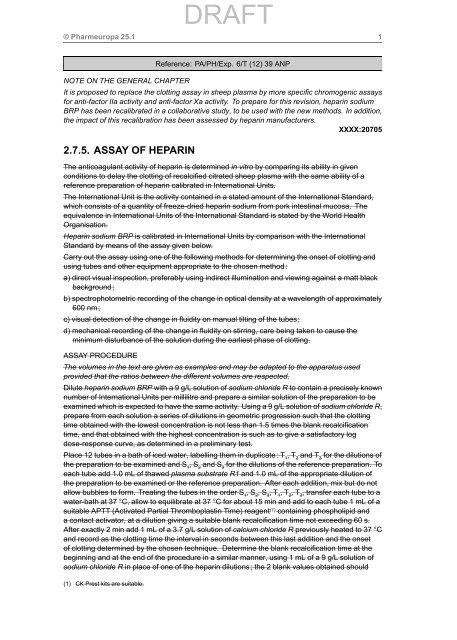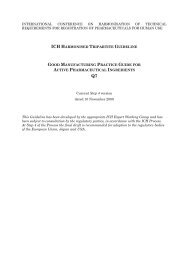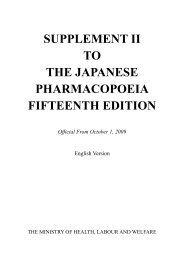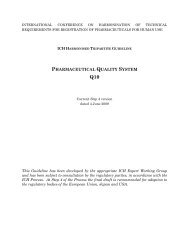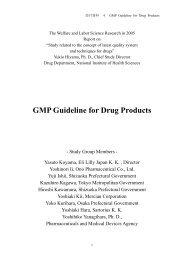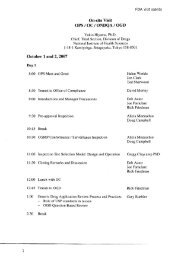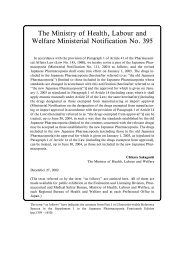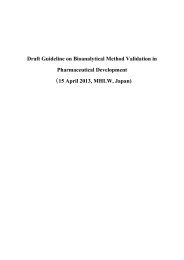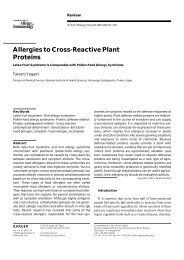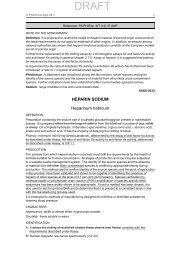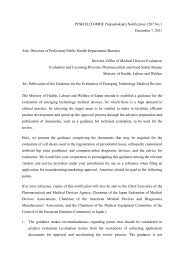2.7.5. ASSAY OF HEPARIN - NIHS
2.7.5. ASSAY OF HEPARIN - NIHS
2.7.5. ASSAY OF HEPARIN - NIHS
You also want an ePaper? Increase the reach of your titles
YUMPU automatically turns print PDFs into web optimized ePapers that Google loves.
DRAFT<br />
© Pharmeuropa 25.1 1<br />
Reference: PA/PH/Exp. 6/T (12) 39 ANP<br />
NOTE ON THE GENERAL CHAPTER<br />
It is proposed to replace the clotting assay in sheep plasma by more specific chromogenic assays<br />
for anti-factor IIa activity and anti-factor Xa activity. To prepare for this revision, heparin sodium<br />
BRP has been recalibrated in a collaborative study, to be used with the new methods. In addition,<br />
the impact of this recalibration has been assessed by heparin manufacturers.<br />
XXXX:20705<br />
<strong>2.7.5.</strong> <strong>ASSAY</strong> <strong>OF</strong> <strong>HEPARIN</strong><br />
The anticoagulant activity of heparin is determined in vitro by comparing its ability in given<br />
conditions to delay the clotting of recalcified citrated sheep plasma with the same ability of a<br />
reference preparation of heparin calibrated in International Units.<br />
The International Unit is the activity contained in a stated amount of the International Standard,<br />
which consists of a quantity of freeze-dried heparin sodium from pork intestinal mucosa. The<br />
equivalence in International Units of the International Standard is stated by the World Health<br />
Organisation.<br />
Heparin sodium BRP is calibrated in International Units by comparison with the International<br />
Standard by means of the assay given below.<br />
Carry out the assay using one of the following methods for determining the onset of clotting and<br />
using tubes and other equipment appropriate to the chosen method:<br />
a) direct visual inspection, preferably using indirect illumination and viewing against a matt black<br />
background;<br />
b) spectrophotometric recording of the change in optical density at a wavelength of approximately<br />
600 nm;<br />
c) visual detection of the change in fluidity on manual tilting of the tubes;<br />
d) mechanical recording of the change in fluidity on stirring, care being taken to cause the<br />
minimum disturbance of the solution during the earliest phase of clotting.<br />
<strong>ASSAY</strong> PROCEDURE<br />
The volumes in the text are given as examples and may be adapted to the apparatus used<br />
provided that the ratios between the different volumes are respected.<br />
Dilute heparin sodium BRP with a 9 g/L solution of sodium chloride R to contain a precisely known<br />
number of International Units per millilitre and prepare a similar solution of the preparation to be<br />
examined which is expected to have the same activity. Using a 9 g/L solution of sodium chloride R,<br />
prepare from each solution a series of dilutions in geometric progression such that the clotting<br />
time obtained with the lowest concentration is not less than 1.5 times the blank recalcification<br />
time, and that obtained with the highest concentration is such as to give a satisfactory log<br />
dose-response curve, as determined in a preliminary test.<br />
Place 12 tubes in a bath of iced water, labelling them in duplicate: T 1<br />
, T 2<br />
and T 3<br />
for the dilutions of<br />
the preparation to be examined and S 1<br />
, S 2<br />
and S 3<br />
for the dilutions of the reference preparation. To<br />
each tube add 1.0 mL of thawed plasma substrate R1 and 1.0 mL of the appropriate dilution of<br />
the preparation to be examined or the reference preparation. After each addition, mix but do not<br />
allow bubbles to form. Treating the tubes in the order S 1<br />
, S 2<br />
, S 3<br />
, T 1<br />
, T 2<br />
, T 3<br />
, transfer each tube to a<br />
water-bath at 37 °C, allow to equilibrate at 37 °C for about 15 min and add to each tube 1 mL of a<br />
suitable APTT (Activated Partial Thromboplastin Time) reagent (1) containing phospholipid and<br />
a contact activator, at a dilution giving a suitable blank recalcification time not exceeding 60 s.<br />
After exactly 2 min add 1 mL of a 3.7 g/L solution of calcium chloride R previously heated to 37 °C<br />
and record as the clotting time the interval in seconds between this last addition and the onset<br />
of clotting determined by the chosen technique. Determine the blank recalcification time at the<br />
beginning and at the end of the procedure in a similar manner, using 1 mL of a 9 g/L solution of<br />
sodium chloride R in place of one of the heparin dilutions; the 2 blank values obtained should<br />
(1) CK Prest kits are suitable.
DRAFT<br />
2 © Pharmeuropa 25.1<br />
not differ significantly. Transform the clotting times to logarithms, using the mean value for the<br />
duplicate tubes. Repeat the procedure using fresh dilutions and carrying out the incubation in the<br />
order T 1<br />
, T 2<br />
, T 3<br />
, S 1<br />
, S 2<br />
, S 3<br />
. Calculate the results by the usual statistical methods (5.3).<br />
Carry out not fewer than 3 independent assays. For each such assay prepare fresh solutions of<br />
the reference preparation and the preparation to be examined and use another, freshly thawed<br />
portion of plasma substrate.<br />
Calculate the potency of the preparation to be examined, combining the results of these assays,<br />
by the usual statistical methods (5.3). When the variance due to differences between assays<br />
is significant at P = 0.01, a combined estimate of potency may be obtained by calculating the<br />
non-weighted mean of potency estimates.<br />
The anticoagulant activity of heparin is determined in vitro by its ability to accelerate the inhibition<br />
of thrombin, factor IIa (anti-IIa assay), by antithrombin. The International Unit is the activity<br />
contained in a stated amount of the International Standard for Unfractionated Heparin. Heparin<br />
sodium BRP, calibrated in International Units by comparison with the International Standard using<br />
the 2 assays given below, is used as reference preparation.<br />
For anti-IIa and anti-Xa assays, carry out the assay by determining the absorbance (end-point<br />
method) or the change of absorbance per minute (kinetic method) using tubes, microtitre plates<br />
and other automated equipment as appropriate to the chosen method.<br />
ANTI-FACTOR IIa ACTIVITY<br />
Reference and test solutions. Prepare 4 independent series of 4 dilutions each, of the substance<br />
to be examined and of heparin sodium BRP in tris(hydroxymethyl)aminomethane-EDTA buffer<br />
solution pH 8.4 R1; the concentration range must be within 0.005 IU to 0.03 IU per millilitre and<br />
the dilutions chosen must give a linear response when results are plotted as absorbance against<br />
log concentration.<br />
Procedure. Label 16 tubes for the dilutions of the substance to be examined and 16 tubes for<br />
the dilutions of the reference preparation: T 1<br />
, T 2<br />
, T 3<br />
, T 4<br />
for each of the 4 series of dilutions of the<br />
substance to be examined and S 1<br />
, S 2<br />
, S 3<br />
, S 4<br />
for each of the 4 series of dilutions of the reference<br />
preparation. To each of the 32 tubes add 100 µL of antithrombin III solution R5 and 50 µL of either<br />
tris(hydroxymethyl)aminomethane-EDTA buffer solution pH 8.4 R1 or the appropriate dilution of<br />
the substance to be examined or the reference preparation. After each addition, mix but do not<br />
allow bubbles to form. Treating the tubes in 2 subsequent series in the order S 1<br />
, S 2<br />
, S 3<br />
, S 4<br />
, T 1<br />
, T 2<br />
,<br />
T 3<br />
, T 4<br />
, T 1<br />
, T 2<br />
, T 3<br />
, T 4<br />
, S 1<br />
, S 2<br />
, S 3<br />
, S 4<br />
, allow to equilibrate at 37 °C (water-bath or heating block) for at<br />
least 1 min and add to each tube 25 µL of human thrombin solution R2. Incubate for exactly 1 min<br />
and add 50 µL of chromogenic substrate R6.<br />
For the kinetic method, transfer the mixtures to semi-micro cuvettes and measure the change in<br />
absorbance per minute (2.2.25) at 405 nm using a suitable reading device.<br />
For the end-point method, stop the reaction after exactly 4 min by adding 50 µL of a 20 per<br />
cent (V/V) solution of glacial acetic acid R. Assess whether exactly 4 min of incubation with the<br />
chromogenic substrate yields the optimal absorbance reading and, if necessary, adjust the<br />
incubation time to give the best dose-response curve. Then, transfer the mixtures to semi-micro<br />
cuvettes and measure the absorbance (2.2.25) at 405 nm using a suitable reading device.<br />
Determine the blank amidolytic activity at the beginning and at the end of the procedure in a<br />
similar manner, using tris(hydroxymethyl)aminomethane-EDTA buffer solution pH 8.4 R1 instead<br />
of the reference and test solutions; the 2 blank values do not differ significantly. Calculate the<br />
regression of the absorbance on log concentrations of the solutions of the substance to be<br />
examined and of heparin sodium BRP, and calculate the potency of the substance to be examined<br />
in International Units per millilitre using the usual statistical methods for parallel-line assays (5.3).<br />
ANTI-FACTOR Xa ACTIVITY<br />
Reference and test solutions. Prepare 4 independent series of 4 dilutions each, of the substance<br />
to be examined and of heparin sodium BRP in tris(hydroxymethyl)aminomethane-EDTA buffer<br />
solution pH 8.4 R1; the concentration range must be within 0.03 IU to 0.375 IU per millilitre and<br />
the dilutions chosen must give a linear response when results are plotted as absorbance against<br />
log concentration.
DRAFT<br />
© Pharmeuropa 25.1 3<br />
Procedure. Label 16 tubes for the dilutions of the substance to be examined and 16 tubes<br />
for the dilutions of the reference preparation: T 1 , T 2 , T 3 , T 4 for each of the 4 series of dilutions<br />
of the substance to be examined and S 1<br />
, S 2<br />
, S 3<br />
, S 4<br />
for each of the 4 series of dilutions of the<br />
reference preparation. To each of the 32 tubes add 50 µL of antithrombin III solution R6 and<br />
50 µL of the appropriate dilution of the substance to be examined or the reference preparation.<br />
After each addition, mix but do not allow bubbles to form. Treating the tubes in 2 subsequent<br />
series in the order S 1<br />
, S 2<br />
, S 3<br />
, S 4<br />
, T 1<br />
, T 2<br />
, T 3<br />
, T 4<br />
, T 1<br />
, T 2<br />
, T 3<br />
, T 4<br />
, S 1<br />
, S 2<br />
, S 3<br />
, S 4<br />
, allow to equilibrate<br />
at 37 °C (water-bath or heating block) for 1 min and add to each tube 100 µL of bovine factor<br />
Xa solution R2. Incubate for exactly 2 min and add 100 µL of chromogenic substrate R7. For<br />
the kinetic method, transfer the mixtures to semi-micro cuvettes and measure the change in<br />
absorbance per minute (2.2.25) at 405 nm using a suitable reading device. For the end-point<br />
method, stop the reaction after exactly 4 min by adding 50 µL of a 20 per cent (V/V) solution<br />
of glacial acetic acid R. Assess whether exactly 4 min 1 of incubation with the chromogenic<br />
substrate yields 2 the optimal absorbance reading and, if necessary, adjust the incubation time<br />
to give the best dose-response curve. Then, transfer the mixtures to semi-micro cuvettes and<br />
measure the absorbance (2.2.25) at 405 nm using a suitable reading device. Determine the<br />
blank amidolytic activity at the beginning and at the end of the procedure in a similar manner,<br />
using tris(hydroxymethyl)aminomethane-EDTA buffer solution pH 8.4 R1 instead of the reference<br />
and test solutions; the 2 blank values do not differ significantly. Calculate the regression of the<br />
absorbance on log concentrations of the solutions of the substance to be examined and of heparin<br />
sodium BRP, and calculate the potency of the substance to be examined in International Units per<br />
millilitre using the usual statistical methods for parallel-line assays (5.3).<br />
Reagents<br />
Tris(hydroxymethyl)aminomethane-EDTA buffer solution pH 8.4 R1. XXXXXXX.<br />
Dissolve 10.20 g of sodium chloride R, 6.10 g of tris(hydroxymethyl)aminomethane R, 2.80 g<br />
of sodium edetate R and 1.00 g of macrogol 6000 or 2.00 g of bovine albumin R or of human<br />
albumin R in 800 mL of water R. Adjust to pH 8.4 with hydrochloric acid R and dilute to 1.0 L<br />
with water R.<br />
Antithrombin III solution R5. XXXXXXX.<br />
Reconstitute antithrombin III R as directed by the manufacturer and dilute to 0.125 IU/mL with<br />
tris(hydroxymethyl)aminomethane-EDTA buffer solution pH 8.4 R1.<br />
Thrombin solution, human R2. XXXXXXX.<br />
Reconstitute human thrombin R as directed by the manufacturer and dilute to 5 IU/mL with<br />
tris(hydroxymethyl)aminomethane-EDTA buffer solution pH 8.4 R1.<br />
Chromogenic substrate R6. XXXXXXX.<br />
Dissolve D-phenylalanyl-L-pipecolyl-L-arginine-4-nitroanilide dihydrochloride in water R to give<br />
a 1.25 mM solution.<br />
Antithrombin III solution R6. XXXXXXX.<br />
Reconstitute antithrombin III R as directed by the manufacturer and dilute to 1.0 IU/mL with<br />
tris(hydroxymethyl)aminomethane-EDTA buffer solution pH 8.4 R1.<br />
Factor Xa solution, bovine R2. XXXXXXX.<br />
Reconstitute as directed by the manufacturer and dilute with tris(hydroxymethyl)aminomethane-<br />
EDTA buffer solution pH 8.4 R1 to obtain a solution that gives an absorbance between 0.65 and<br />
1.25 at 405 nm when assayed according to general chapter 2.7.5 using the end-point method.<br />
Chromogenic substrate R7. XXXXXXX.<br />
Dissolve N-α-benzyloxycarbonyl-D-arginyl-L-glycyl-L-arginine-4-nitroanilide dihydrochloride<br />
in water R to give a 1 mM solution.


